
Weapon (Blade) Designer || Self-taught Digital Artist || Filipino Martial Artist || Writes games sometimes || Mechanical Engineer || Law Student || 25 🇵🇭 twitter.com/KathangLangit || instagram.com/kathang.langit || kathanglangit.itch.io || kathanglangit.carrd.co || kathang.tawen@gmail.com
86 posts
The Fourth Blade: Panabas - "For Chopping"
The Fourth Blade: Panabas - "For Chopping"
Four days to the launch of the white-hot lightning that is the Gubat Banwa Kickstarter! Gubat Banwa is a TTRPG supported by the twin pillars of tactical martial arts and contemplative war drama. Meditate upon love and violence as warriors of a burning world. Will you stem the tide of blades? Or is it rising by your will?

I'll be posting the weapons I've drawn for the game as a countdown until the launch on October 10. This was supposed to be a Swordtember series, but we needed a little more time to gain momentum. 4/7 blades, past the halfway point, let us proceed with the PANABAS
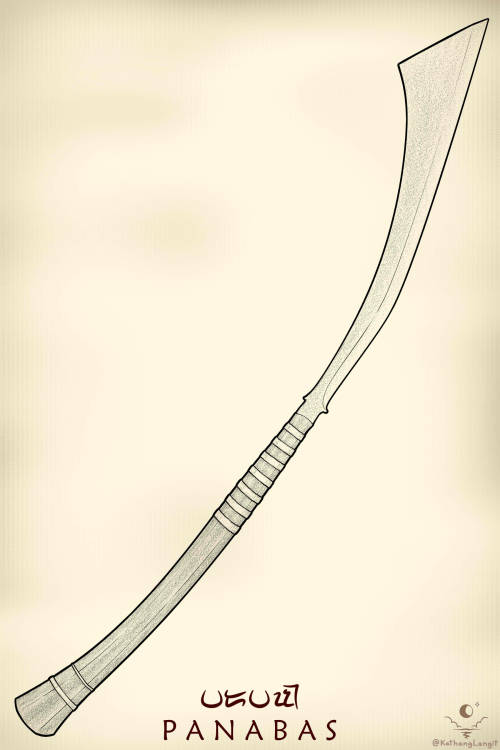
Towering amongst what blade collectors categorize as "Moro weaponry", the panabas is quite possibly the largest blade I've ever drawn. Like- I'm not lying, I drew all the blades in this series to scale relative to each other, and the panabas has by and large been the one determining how big my canvas needs to be. The edge is on the longer curve, the spine of the blade is thicker near the handle, and the handle is about as long as the blade (if not longer).

(Photo from Kristian Josef Acedo)
The form belies the function; it isn't difficult to guess how this blade is used just by looking at it. The name- if I'm not mistaken- is an even bigger giveaway. Panabas supposedly comes from "pang-tabas" which literally means "for chopping". It also goes by the name of nawi.
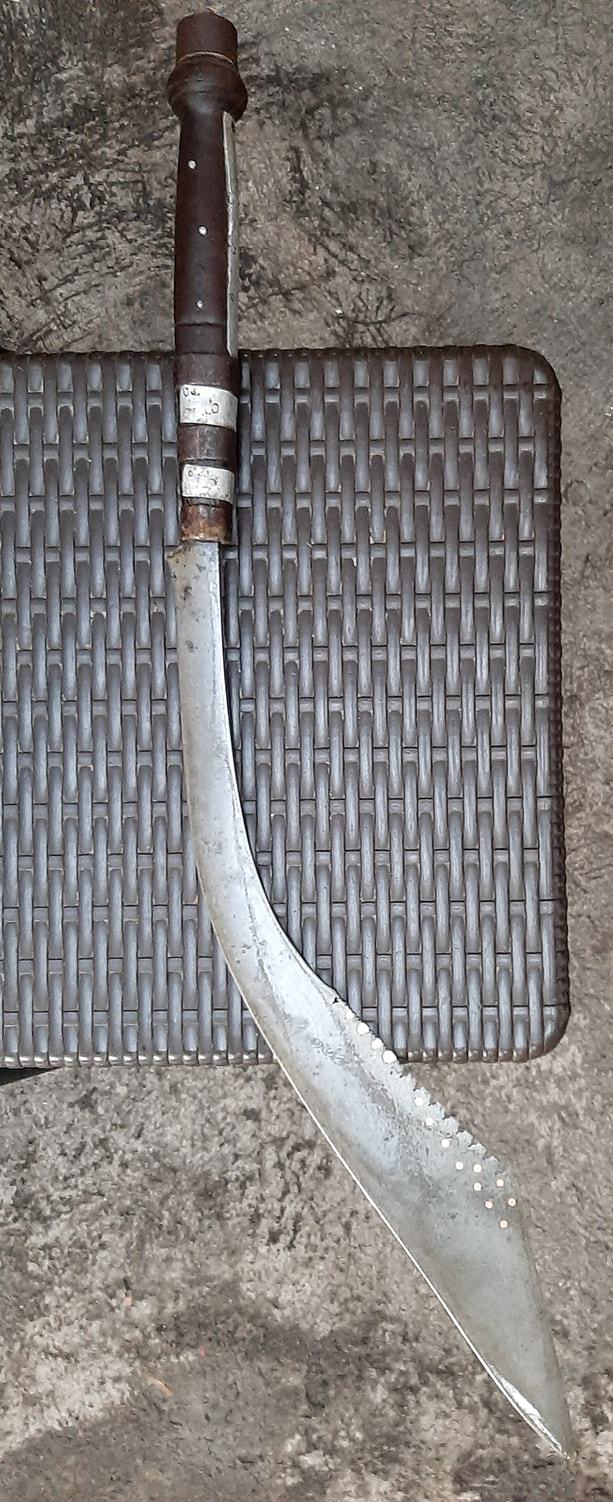

(Photos from Raymundo Lucero) As large as its reputation might be, the choppers aren't always massive. Their utility ranges from agricultural to combative to ceremonial, and the size and shape usually matched the nature of the work.
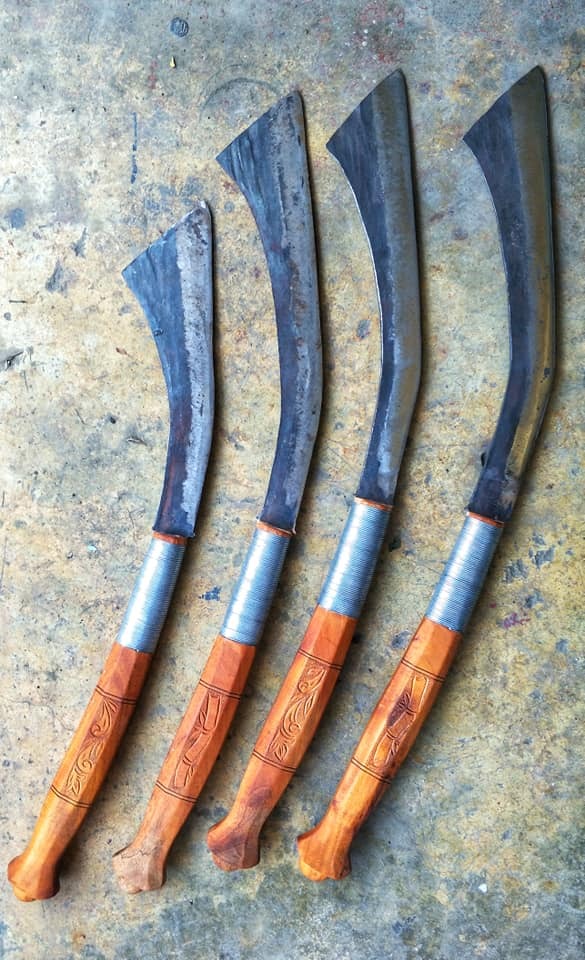
(Tools from Datu Paglas, Maguindanao)
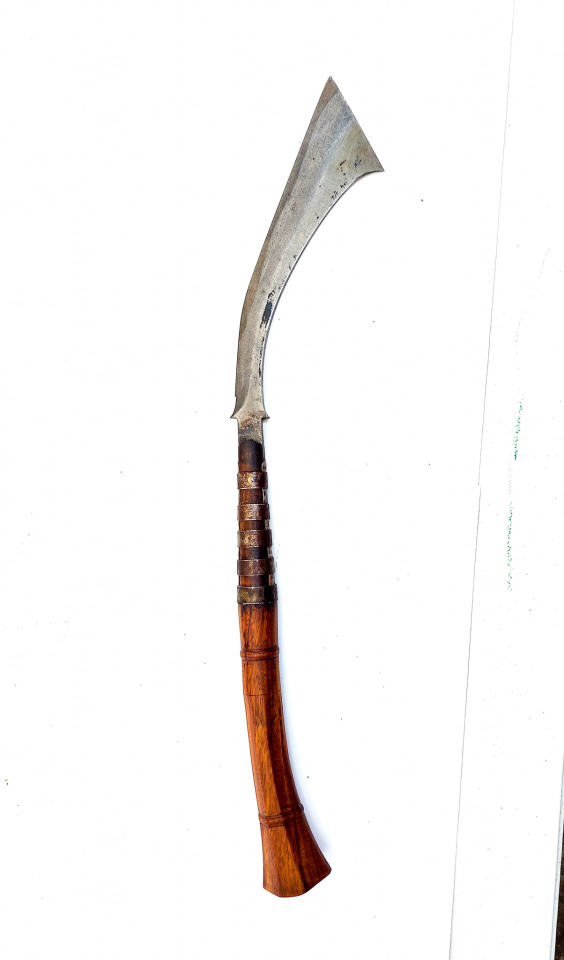
(Photo from Dondon Dimpas)

(Exhibit at Museum of the Filipino People- biggest one) The panabas is most often attributed to the peoples of Maguindanao, though the range of its use and the variants of its make span across large portions of the Mindanao area.

(Antiques from the collection of Richard Hudson, size comparison with a kalis) A popular tale (especially amongst Filipino Martial Artists) states that the US Marines wore leather collars to protect their necks during the American Occupation in Mindanao, due to blades like these that gave the troops pause, and feel that the extra protection was necessary. Supposedly, this is where the term "leatherneck" came from. Although the veracity of this latter claim is a bit on par with the claim that the Colt .45 was invented specifically to stop the same Moro warriors, the story has already stuck.

(Antique from Lake Lanao)

(Photo from The Metropolitan Museum of Art) We touched upon "Traditional" blades last time, referring to blades made by the same people to whose cultures those blades belong. This time we look at the other side of the coin. "Modern" is the term collectors here often use to refer to reinterpretations, usually by modern smiths who are separate from where a blade traditionally belongs. The point of reference I used for "Traditional" blades before is a katana forged by a traditional Japanese swordsmith. If- instead- a white blacksmith in America were to forge a katana using their own smithing methods, that would be considered as a "Modern" blade under this categorization. I'll leave it to you to spot the differences in these next few photos:

Traditional panabas with a rattan ferrule (Photo from Lorenz Lasco)

Modern blades by Jun Deuna (Espanola) and RE Pandayan (Quezon) (Photo from Dennis Andrew Golez)

Traditional blades (Marawi and Maguindanao) (Photo from Dennis Andrew Golez)

Modern full-tang build by Traditional Filipino Weapons (I know who forged this but I won't doxx their location) (Photo from the TFW website)

Modern full-tang build by Batangas Armory (Batangas) (Photo from Job Abat)

Pair of panabas and a binuaya (leftmost) by Traditional Moro Blade, Maguindanaon (Maguindanao)
Say it with me this time! Blade culture is alive and still developing. Mindanao was never conquered by Spain- the fierce resistance of the Moros made sure of that- and again it shows in the blade cultures. Though the panabas is now popular enough to have modern reinterpretations made by smiths across the Philippines, the traditional panabas and the people who make them are still around.
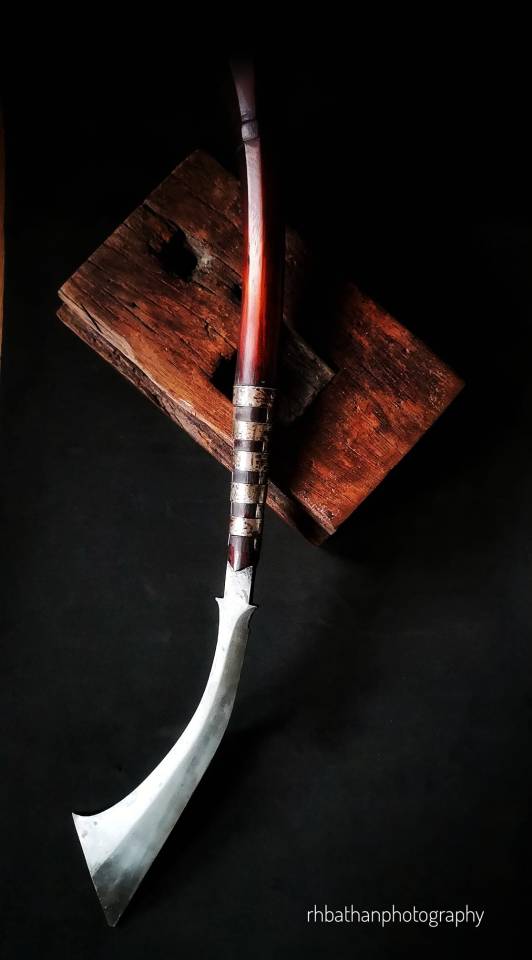
(Photo from Iniingatang Talim at Kaluban, taken by Ramon H. Bathan)
One of the Five Major Mahamandalas of Gubat Banwa pays homage to and gleans inspiration from living cultures like those I mentioned here. Yes- I repeated the text from the previous installment, because it's equally true, here. Additionally, the panabas shows up as the iconic weapon of the Martyr- one of the 25 Disciplines (read: "character classes") whose moon-bright martial techniques you could pick up in-game. Anyway, go check out the Kickstarter!
The Gubat Banwa Kickstarter launches in 4 days! Check it out here:

Not long now- this is a very small team of creators from the global south knocking on your doors asking for help to get the word out. I truly cannot understate how small this team is, and how amazing it is that they've come this far- we just need a little bit of a boost! With your help, this grand ambition can be realized. We would greatly appreciate any help rendered towards getting more eyes on this game!
-
 mori-bun liked this · 1 year ago
mori-bun liked this · 1 year ago -
 talps90 liked this · 1 year ago
talps90 liked this · 1 year ago -
 velveteen-mango liked this · 1 year ago
velveteen-mango liked this · 1 year ago -
 weirdoshutin liked this · 1 year ago
weirdoshutin liked this · 1 year ago -
 senioran liked this · 1 year ago
senioran liked this · 1 year ago -
 healingvamp liked this · 1 year ago
healingvamp liked this · 1 year ago -
 bennoni reblogged this · 2 years ago
bennoni reblogged this · 2 years ago -
 bennoni liked this · 2 years ago
bennoni liked this · 2 years ago -
 doc-coyote liked this · 2 years ago
doc-coyote liked this · 2 years ago -
 indiepressrevolution reblogged this · 2 years ago
indiepressrevolution reblogged this · 2 years ago -
 raptoroferebus liked this · 2 years ago
raptoroferebus liked this · 2 years ago -
 carthus-flame-arc reblogged this · 2 years ago
carthus-flame-arc reblogged this · 2 years ago -
 brandnewbuanny reblogged this · 2 years ago
brandnewbuanny reblogged this · 2 years ago -
 barfsquid liked this · 2 years ago
barfsquid liked this · 2 years ago -
 froggersxd liked this · 2 years ago
froggersxd liked this · 2 years ago -
 poelmo reblogged this · 2 years ago
poelmo reblogged this · 2 years ago -
 durzanightshadeblack liked this · 2 years ago
durzanightshadeblack liked this · 2 years ago -
 alleo-i reblogged this · 2 years ago
alleo-i reblogged this · 2 years ago -
 riibread liked this · 2 years ago
riibread liked this · 2 years ago -
 sentientmoths reblogged this · 2 years ago
sentientmoths reblogged this · 2 years ago -
 sentientmoths liked this · 2 years ago
sentientmoths liked this · 2 years ago -
 electronic-old-men liked this · 2 years ago
electronic-old-men liked this · 2 years ago -
 blackfire5561 liked this · 2 years ago
blackfire5561 liked this · 2 years ago -
 indiepressrevolution liked this · 2 years ago
indiepressrevolution liked this · 2 years ago -
 arceusofficial liked this · 2 years ago
arceusofficial liked this · 2 years ago -
 ace-of-dragons liked this · 2 years ago
ace-of-dragons liked this · 2 years ago -
 lailanihan reblogged this · 2 years ago
lailanihan reblogged this · 2 years ago -
 mr-bottle-28-3-96 reblogged this · 2 years ago
mr-bottle-28-3-96 reblogged this · 2 years ago -
 mr-bottle-28-3-96 liked this · 2 years ago
mr-bottle-28-3-96 liked this · 2 years ago -
 aaitwo liked this · 2 years ago
aaitwo liked this · 2 years ago -
 ghost--bot reblogged this · 2 years ago
ghost--bot reblogged this · 2 years ago -
 ghost--bot liked this · 2 years ago
ghost--bot liked this · 2 years ago -
 queenbidoof liked this · 2 years ago
queenbidoof liked this · 2 years ago -
 cutecuttlefish reblogged this · 2 years ago
cutecuttlefish reblogged this · 2 years ago -
 cutecuttlefish liked this · 2 years ago
cutecuttlefish liked this · 2 years ago -
 endorphinmachine reblogged this · 2 years ago
endorphinmachine reblogged this · 2 years ago -
 peripendicular reblogged this · 2 years ago
peripendicular reblogged this · 2 years ago -
 toothbastard liked this · 2 years ago
toothbastard liked this · 2 years ago -
 toothbastard reblogged this · 2 years ago
toothbastard reblogged this · 2 years ago -
 dreamyyartist liked this · 2 years ago
dreamyyartist liked this · 2 years ago -
 majjiktricks liked this · 2 years ago
majjiktricks liked this · 2 years ago -
 kadkadduwa liked this · 2 years ago
kadkadduwa liked this · 2 years ago -
 arpiniko liked this · 2 years ago
arpiniko liked this · 2 years ago -
 birbwell reblogged this · 2 years ago
birbwell reblogged this · 2 years ago -
 anyonghalimaw reblogged this · 2 years ago
anyonghalimaw reblogged this · 2 years ago
More Posts from Kathanglangit
Forging onwards! It certainly doesn't help when blades are found far from home and are labelled with confusing specific terms or useless general terms or just different terms entirely.
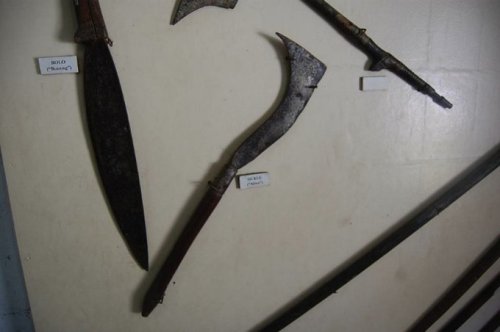
("Sickle" from Father Jose Burgos Museum)

(Photo labelled "Sinawit" by some random person on the internet)
But we said we'll try! So take a deep breath and bear with me as I try to parse this. As far as I can tell, aliwa seems to be an almost general term for Isneg axes. I could be wrong. The long-bladed, long-handled ones might be the binaroy variant of the aliwa.

And then we get thrown for a loop again. A collector was informed of ancient Ibanag "vunang" (so- buneng?), only to be shown Isneg blades- an aliwa and a binawit- the latter turning out to be called a bokog. Is this aliwa a binaroy? What's a bokog?
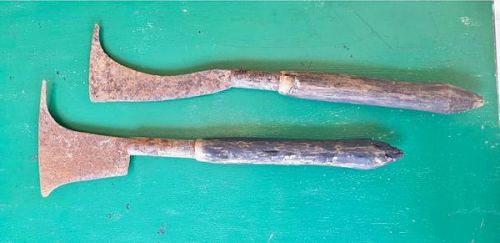
(Photo from Jake Coballes) And then something like this shows up and the earliest source you can find is a comment on a random Facebook post and you have to wonder if this is: a) A variant of something you know; b) Something else entirely; c) Some modern smith mixing influences; OR d) A secret 4th thing

Moving on- I'm entirely unsure if badon/badan refers to those with the short handles or those with this kind of blade. It may well be either or both, but I'm leaning towards it being the blade shape. The curve is a bit more pronounced, and it's not as long as the binaroy.

(Photo from the Penn Museum) (Photo from Nonoy Tan) Another point of confusion: This dagguerreotype from the Real Military Museum bears a label referring to the axe as an aligua/aliwa, but it looks to me more like what we've just decided a gaman looks like.

(Photo from the archive of Narciso Clavería y Zaldúa) And sometimes you see something interesting: small axes worn as hair ornaments. The word liwa/ligua gets thrown around referring to the axe, with iko/ko for the type worn in hair. I sometimes wish I were a proper history scholar.

(Photo from the Meerkamp van Embden collection) Modern renditions don't necessarily help very much when you're trying to pin down the identity of a traditional blade. Still, the fact that they're around means the blade culture is alive and- you get the deal by now.

(Blade by WOW Banaue Souvenirs; Photo from Job Abat) In fact, modern renditions like these are sometimes integral to the preservation of traditional forms. The BUNENG is the Ibanag variant of the axe, which has apparently gone extinct in most communities. There's an interesting story behind these photos shared by Jake Coballes:
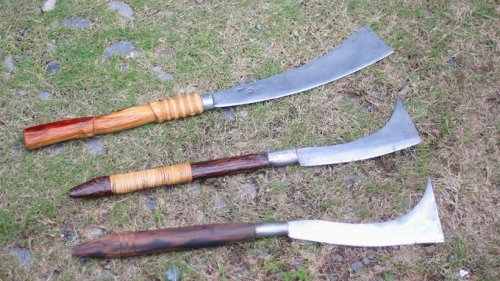
The top blade was made by a modern smith in Tuguegarao (Itak Direct Selling), which the collector posits may have been a sign of Ibanag influence reaching Cagayan.
The bottom blade is a modern aliwa (Isagaddan Crafts)
The Isneg and Ibanag have neighboring territories; The middle is an attempt by a modern smith to recreate the Ibanag bunang using a related blade- the Isneg aliwa- as a reference. I couldn't find many old reference photos of the buneng/bunang, but recreations abound, and it is not yet fully extinct amongst all Ibanag communities.
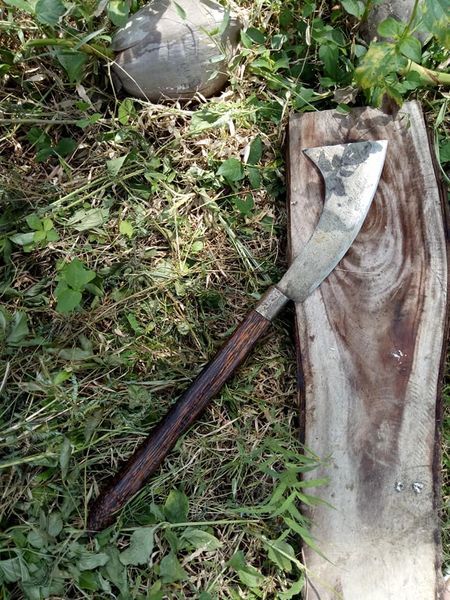
(Recreation by Jake Coballes as shared by PBH) (Modern rendition by an Ibanag panday, photo from Villanueva Clive) Much to my chagrin, I could not find much on the Kankana-ey variant, despite being Kankana-ey myself. And we're still around, traditions well-preserved, though the times have changed. Imagine the frustration of those from whom colonization took much, much more.
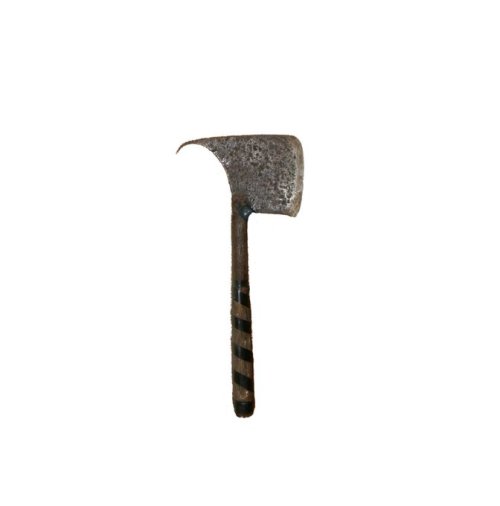
(Photo from an Italian blog of all places) The Kankanaey were one of the peoples alongside all the others mentioned here- and a few not mentioned- who engaged in the practice of headtaking. Heads were taken for various reasons- ritual mourning, revenge, rites of passage. Tattoos were earned by those who succeed. The Cordilleran peoples count among the cultures in the Philippines who have tattooing traditions.
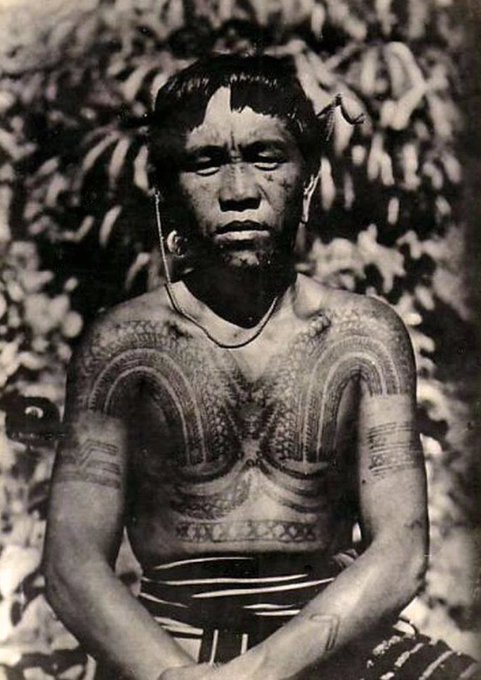
(Bontoc man with "chaklag" fern tattoos) Stories abound about the north Luzon headtakers, and the "headaxes" earned their name alongside the warriors that wield them. Everyone knew to be wary: Neighbouring peoples, lowlanders near the mountains, Spanish conquistadors- There are many reasons cited for why Spain never took the Cordilleran mountain range: horses being unable to maneuver slopes, firearms not working in the higher altitudes, pacified settlements being empty when the Spanish government returned due to the Cordillerans being semi-nomadic. Some say it was fear that kept Spain from conquering these peoples, the fear that their heads would stain the ground as red as the mountain soil, if they made the climb.

I hesitate to call them headaxes- though many surmise the spike was for picking up heads, the blade itself functioned as a multi-tool. They were used for construction, for chopping wood, and in some cases even circumcision. These blades were used to live- to preserve a way of life- as are all the native blades of the Philippines.

(Photo from Lorenz Lasco) I wouldn't use the word "headhunter" either, as it was used as a derogatory term. Give this a read, if you can stomach it, if you want to know more.

But this thread is long enough, and there will always be more to learn. Especially when the people to learn from are still around and talking. I have a lot to study on myself; I can't pretend the knowledge I share is perfect, I can only ever hope it's adequate. The Cordilleran Ax shows up in the hands of the aptly named Headtaker of the Sword Isles, one of the many disciplines whose techniques your characters can learn in the game.
The Gubat Banwa Kickstarter launches in 2 days! Check it out here:

Two more days! This very small team of creators from the global south needs your help to get eyes on this project. You can read about the people behind Gubat Banwa on this Twitter X thread.
The Sixth Blade - ... - Fear Itself
Last two days! Gubat Banwa launches on Kickstarter on October 10, and we need your help to get the word out! Silence your fear- stifle it if you must. Harness it if you can. Fear begets hesitation, Kadungganan, and when rivers bleed, and skies burn, and blades dance to the rhythm of cannonfire- Hesitation is death. Let the Sword Isles of Gubat Banwa paint your stories in its thousand colors, inspired by the intricate cultures of Southeast Asia. Carve your legacy into the world by blade and smoke as warrior Kadungganan in this tactical martial arts TTRPG.
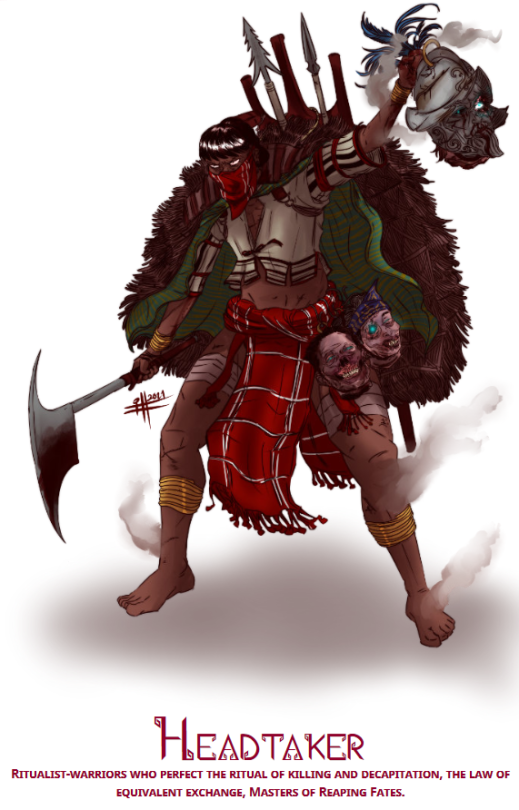
Not long now until the long-anticipated KS launch, and I've been posting the weapons I've drawn for the game as a sort of countdown. These were supposed to be Swordtember drawings, but the launch got bumped back a little bit. 6/7 blades! The penultimate entry goes to the CORDILLERAN AXE

Some time in June 2020, a certain weapon was intercepted in Australia entering the country from the United States. An ancient terror-weapon, which brought low the conquistadors of old, and drenched the soil of the pine mountains such that the ground remains the color of rust. In November the following year, the ax was returned to the Philippines. Strap in- it's about to get really convoluted.

(Photo from the Philippine Embassy in Australia) You may be wondering why I referred to this blade as a "Cordilleran Ax" rather than using a native term like in the rest of this series. That is mostly because the ax comes in many forms, and bears many, many names. Seriously, you wouldn't believe how many names there are for these things.
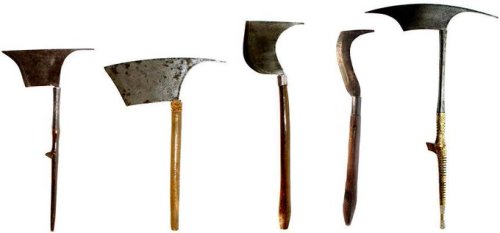
(Photo from the collection of Nonoy Tan) They are commonly called "head axes" (we'll get to why in a minute- but you can probably guess), referring to a collective of different blades of a more-or-less similar shape, used by the peoples of the Cordilleras. "Igorot" is a general term used to refer to these peoples of the mountains of north Luzon.

(Diagram by Lorenz Lasco)
You will recall from the thread on the hinalung that Spain never took the Cordilleras, allowing the peoples there to more easily preserve their traditions and cultures. These axes belong to some of those same cultures. These- too- were preserved from way back.

(Figure from The Tingguian: Social, Religious, and Economic Life of a Philippine Tribe by Fay-Cooper Cole) It's easy to forget that these objects- all of the blades I've been posting about- are very deeply embedded in cultures that still exist today. These peoples have their own names and stories and knowledge of these blades that I simply do not have access to the way they do. It's all I can do to try and deliver accurate info without misrepresenting anything.

(Photo from the National Museum) And try I have. This is a diagram I tried to make as a reference, way, way back.
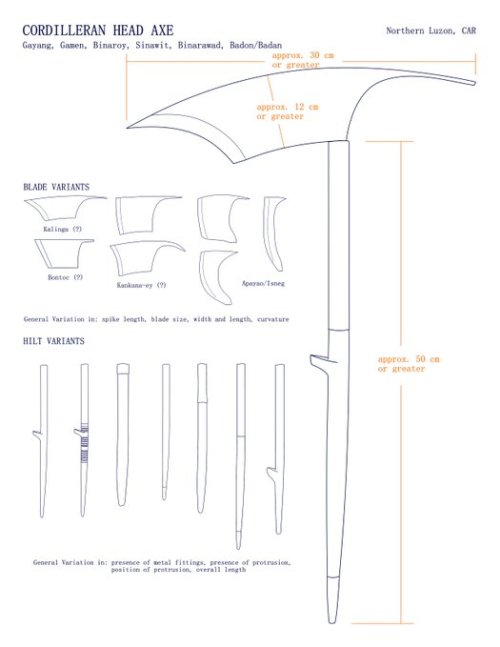
I know a bit more now, I'm not sure if I still stand by this, I am sure that it will need some updating. Due diligence is the bare minimum we can do, to respect the knowledge of people who are still around. Allow me to try again! The one I drew in the image at the start of this thread is called the SINAWIT. This is the Kalinga variant of the axe. From what I can tell, those with the curved/concave cutting edges tend to belong in this category.

(Photo from Pinoy Blade Hunter) Supposedly, the protrusion on the handle is also indicative of a Kalinga origin.
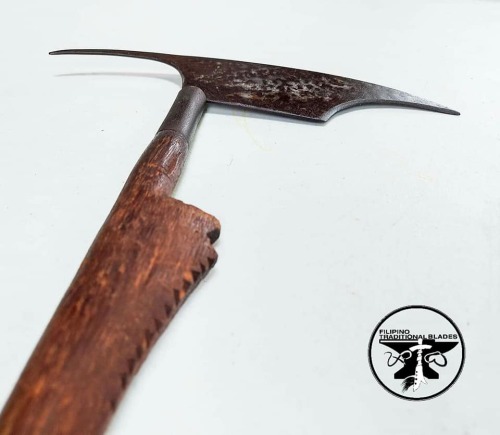
(Photo from Ursulo of Filipino Traditional Blades)
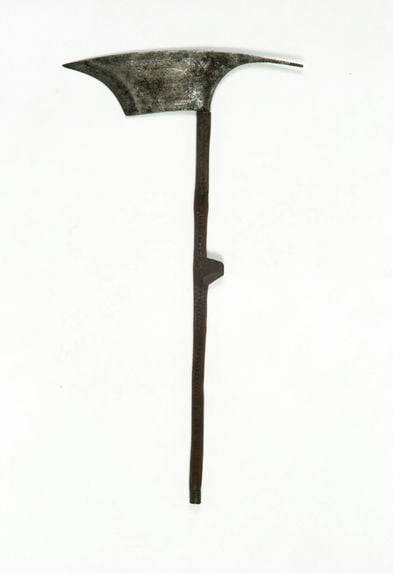

(Photos from Global Inventory of Filipiniana Artifacts) Here's some close-ups of another example, featuring ornamentation in the form of copper/copper-alloy "staples" along the handle, which may have also aided in providing grip.
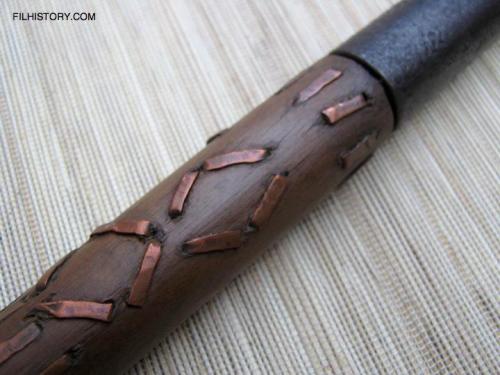

(Photos from Lorenz Lasco) Variations in size are common across all the axes we'll be looking at, some are short and fit well in one-hand, others are large enough to accommodate two. The biggest ones I've seen are sinawit.

(Photo from Christian Vasquez of Filipino Traditional Blades)

(Photo from Ron Zambarrano) Next up is the GAMEN or GAMAN. This is the Bontoc variant of the axe. Here's a gamen (top) compared to a sinawit (bottom) of similar size. Notice the difference in the shapes of the blades.

(Photo from the collection of Zel Umali as shared by Filipino Traditional Blades) Another term that gets thrown around is "pinagas", though I believe this is a general term referring to all "head axes" rather than one specific variant. I could very well be wrong on this, as the word pinagas has to come from one of the many languages in the Cordlieeras- I'm just not certain which. This one was labelled "Bontoc pinagas".

(Photo from Zel Umali) The thickness of the blade tends to vary as durability requires. In particular, the spike on the back tends to be thicker overall. Portions of the blade closer to the handle appear to be thicker as well.


(Photos from Lorenz Lasco) Examples of the gaman as I have seen them tend to have more straight or sometimes convex blades. I am uncertain if the convex shape is a unique feature, or a product of happenstance, or just how whoever used this blade liked to sharpen it.

(Photo from Pinoy Blade Hunter) They also tend to be "taller" than sinawit I've seen, with blades that are almost like squares with spikes on the back, as opposed to sinawit that are more rectangular. Still following so far? Good- it's going to get more complicated soon.


I am not- by any means- formally educated on Philippine blades, so always take my words with a grain of salt. This ax inherited by a blacksmith in Baguio is something that might be gaman, but I can't categorize it with certainty without knowing more. The profile is not exactly the same, the spike is considerably longer and more curved.

(Photo from HanYan Blades) But that's the least of our worries! The ALIWA, BINARAWAD, BADAN, BADON, BINAROY are only some of the terms used to refer to the Isneg variants. Remember when I said it would get convoluted?
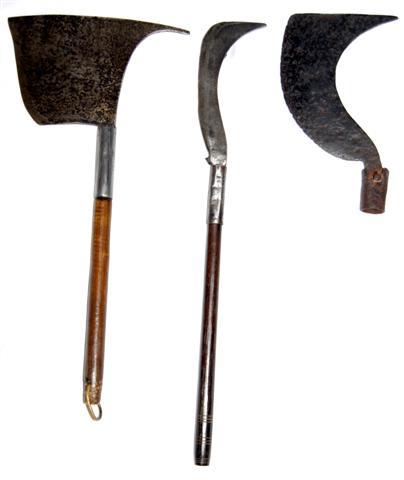
(Photo from Nonoy Tan; Identified as binarawad-badan-badon in that order) The binarawad in the previous photo looks- to my very untrained eye- to be similar to the gaman in many respects. Whenever I think I've identified a distinction, a different specimen shows up.

(??? from Rob Miller)

(Gaman(?) from Hearst Museum) Remember when I said the protrusion on the handle was uniquely Kalinga? But I also said taller/squarer blades were common in gaman? But the swept shape on the back looks emblematic of the Isneg variants we just saw? Identify that topmost blade for me, real quick.

(Photo from Pinoy Blade Hunter) Material exchange of culture makes a mess of categorization. The peoples of the Cordilleras regularly interacted- by trade, union, or warfare- and the influences clearly went all ways. Perhaps that blade above was made by a smith who took influences from a variety of sources. Perhaps the blade itself has worn out its old handle, and the new owner replaced it with this one There are a lot of ways this could have come about, it's difficult to say. Blades tend to make their way around. This sinawit- a Kalinga blade- has been passed down through generations, and was found in Sagada.

(Photo from Pinoy Blade Hunter) It certainly doesn't help when blades are found far from home and are labelled with confusing specific terms or useless general terms or just different terms entirely.
[Author's Note: Apparently there's a 30 image limit per post? I'll continue this in a reblog, I think.]
So- um-
How do I put this...
This humble rock-stacking game of mine has recently won an award!
Specifically, it is 1 of 20 winners of The Awards (2023), coordinated by Nico MacDougall with a panel of several lovely judges.

I'd love to say I'll be putting the game on sale to celebrate, but it's already free (or pay-what-you-want, technically). If you want to see for yourself whatever the judges saw in it that's fit to be remembered, you can go ahead and grab it right now for the cost of only the few megabytes of memory it takes to store it. The itch link can be found in the post above. Be sure to check out the other winners in this Twitter thread! My entry may be among the most wistful, but it is not the most exciting, nor the most mysterious, nor the most thought-provoking, laser-shooting, word-twisting, cyberpunking thing on the list by far. Every single one of these wonderful creations deserves their time in the spotlight.
Congratulations to all the winners, and my heartfelt gratitude to everyone behind The Awards 2023!

Hello again! I know this account is mostly my art and weapon designs, but I think it's about time I actually post about the games I write (since Tumblr allows me to make long text posts, as opposed to the burning bluebird site).

I designed this little game built around memories some time ago. You play with one (1) other person, working together to build a stack of rocks, and recalling your past together.
You take turns recalling your memories of each other, and adding a rock to your stack. The more it grows, the more precarious things become.
It's a bit of a wistful one, for those who like to lounge in daydreams, and those who lie bothered by small heartaches at night.

Is it- strange to say that it's a game that I, myself, am afraid to play?
River, mountain, field, or sea- no one knows where a rock may have come from or where it may end up, before and after it crosses your hands.
I don't- I can't- know where I reside in the memories of those I hold dear. Do we hold the same things close to heart? Do the memories we share, which I cherish in my mind, languish and fade in theirs? What is it that keeps people together? What is it that "we" are built upon?
What would it take to break things apart?

You can get it for free (it's pay what you want) on my itch page, here:


Dugong (Dugong dugon)
@ martin_the_mako_kostal
WEAPON COMMISIONS OPEN

Weapon design commissions by a martial artist and engineer! I make blueprints and weapon designs to arm you and your OCs respectively. Ever wanted to hold a sword of your own? If you live in the Philippines, I can also help you connect with local blacksmiths who can help bring your ideas to life. If you live elsewhere, you can commision me for a blueprint that you can bring to a forge near you. From the deepest reaches of untouched seas,

To the searing light of burning skies,

To the muted glow of stars beyond,

And- perhaps-



To the palm of your hand?
Your next legendary weapon awaits.
Contact me for samples and terms of service at kathang.tawen@gmail.com
The Seventh Blade: Kalis - Bleeding Edge
And so- in the end- the wheel must turn, and a new day must usurp the old. Perhaps then, these long-fallen flowers will feed the soil, and nourish a new bloom. Perhaps the fire will find home in the bleeding rivers and cauterize the land, and the steam will rise into skies of the clearest blue. Perhaps our songs will be of triumphant yesterdays, hard-won and now bearing fruit. But we are Kadungganan- we do not sit idly to await the dawn. We claw at heaven to bring forth our own tomorrow! One more day until the launch of the Gubat Banwa Kickstarter! Fight for another day in the turbulent fires of the Sword Isles, carving out your own story by blade and sheer will in this tactical martial arts TTRPG, inspired by the thousand, thousand colors of Southeast Asia.

I've been posting weapons I've drawn for the game to count down the final week before the launch. This was supposed to be for Swordtember, but the deadline had to be pushed back. 7/7 blades, ending with the KALIS

This blade adorns the logo of Gubat Banwa, at once uniting and splitting in twain. Kalis refers to a number of uniquely Philippine variants of the more widely known collective of kris blades, which appears in several forms across Southeast Asia.

(Diagram by Lorenz Lasco) What separates Philippine kalis from kris seems to be an answer with multiple facets. Some say it's a linguistic matter, others say kalis refers specifically to certain blades from the Sulu archipelago.
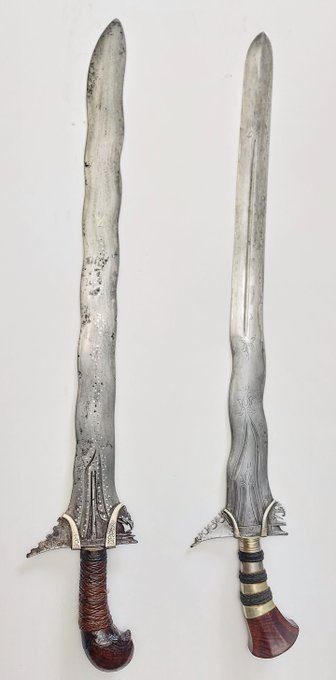

(Photos from Raymundo Lucero)
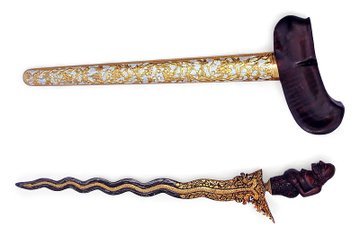
(For comparison, an Indonesian kris) Admittedly, the kalis is a bit of a blindspot in my knowledge. I've done what research I can, and asked those who know better, but I exist a considerable distance away from where these blades belong- physically and culturally. This is, perhaps, where I will be most prone to making mistakes of fact with the information I present. If I make any mistakes, please do not hesitate correct me!

(Photo from Zambasulta Pakukus) On the heels of that disclaimer, let's take a look at the blade. This is definitely one of the most beautiful weapons I've ever had to draw. Philippine kris/kalis tend to be longer and more "sword-like" than those of our neighbors.


(Photos from Johnwick Cabrera) The hilts tend to differ depending on who makes them. Some sport what might be cockatoo/"kakatua" bird-head hilts, some have very ornate junggayan hilts, some feature okir carvings, some are more rudimentary.

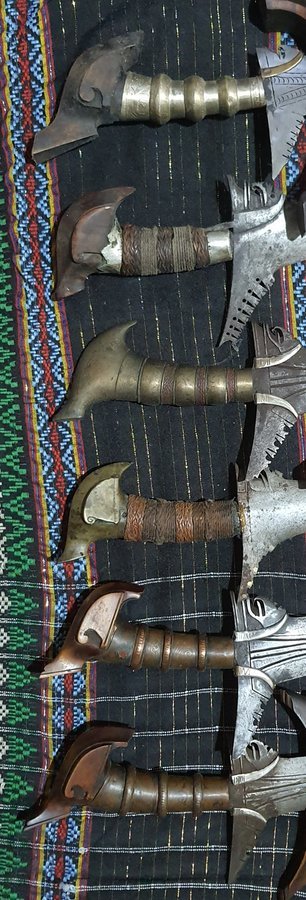
(Photos from Dennis Andrew Golez) The blade is used by several peoples in the south Philippines, including the Maranao, the Tausug, and the peoples of Maguindanao. I am most definitely missing a few groups, this is not an exhaustive list. There are differences between the way they build hilts and assemble blades that I don't feel qualified to speak about. And yes, the blades are like that because they are an assembly near the handle.

(Photo from Sulu Utak Shop) Apart from hilt shape and assembly, variations occur in blade thickness, ornamentaion, presence and type of okir carvings, number of curves or seko (odd numbers), length (kalis sundang = "swords", kalis gunong = "daggers") Actually- you know what?

(Photo from Richard Hudson) Since this is the last one in the countdown, I'm going to do something different. I invite you to find the answers yourself. That is part of what Gubat Banwa is meant to be: an invitation to engage in a fantasy setting centered on our cultures, so you can tell stories built on our terms. The cultures in the Sword Isles are NOT the cultures in the real world from which they draw inspiration. It is very much still a fantasy setting. But part of engaging with the setting in good faith is doing your own learning, on things for which you are not owed an explanation. Curiosity rewards the adventurous. The kalis is well-researched. If you're curious about something, you'll find the answers. You don't need me to hold your hand.
Instead, I'm just going to show you some of the coolest kalis I've seen.


(Silver and ivory-hilted kalis from the NCAA) A (relatively) simple but gorgeous build by a modern smith.

(Blade by Zambasulta Pakukus) A pair of kalis from a smith in Zamboanga.


(Blade by Panday Onsboy Maktar) Silver-hilted kalis from Sulu.
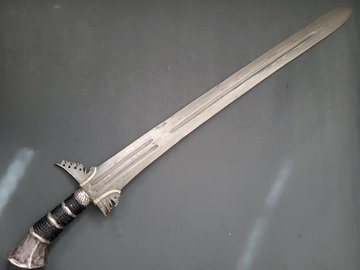

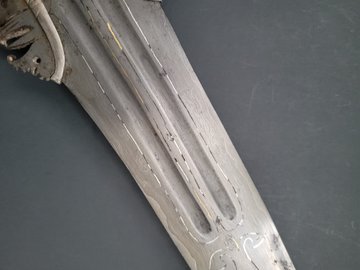
(Photos from Arma Filipinas; Polished by the "Blade Barber") Kalis with some gorgeous carvings on it.

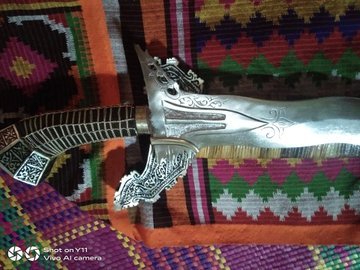
(Photos from Sulu Utak Shop) Kris inlaid with a brass naga.

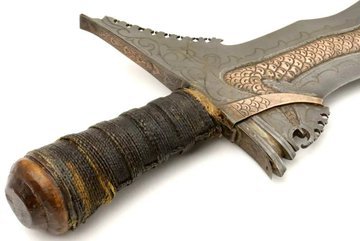
(Photos from Ron Zambaranno) Kalis rehilted by a Lumad group- uncertain which group. Supposedly, the Lumad would take kris they captured from enemies, disassemble them, and rehilt the blade.

This one appears to have a blade that looks like most of the kalis we've seen, but with a hilt similar to Indonesian or Malaysian variants.
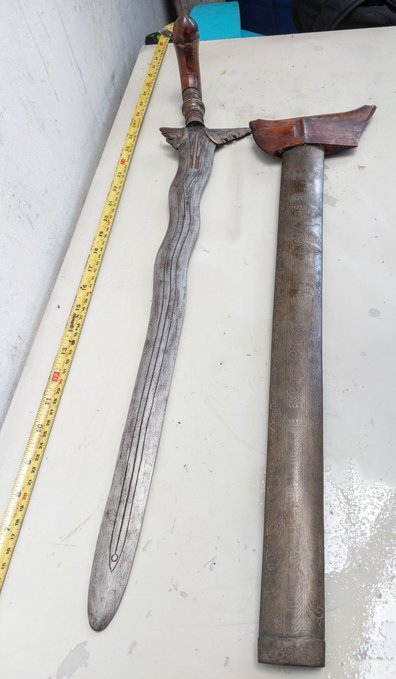
(Photos from Raymundo Lucero) Antique Moro kris sundang with a hilt made of fossilized mammoth tooth, ornamented with a silver coin from the 1700s. A personal favorite, as I used the hilt as a reference for one of my favorite designs.
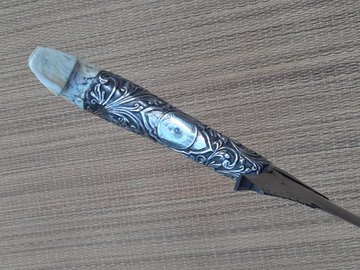
(Photo from Richard Hudson)
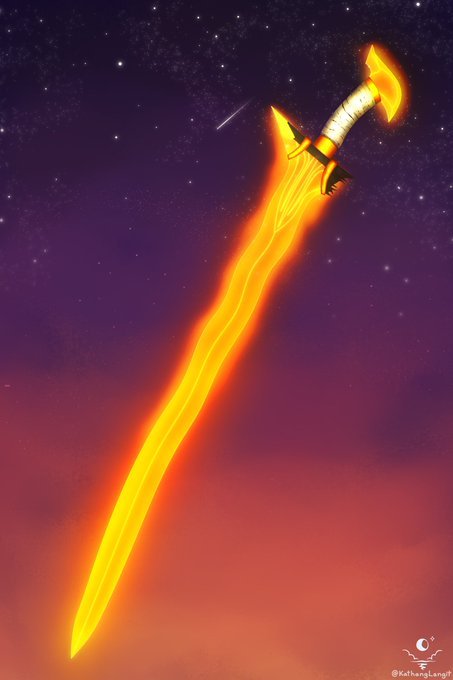
(Art by yours truly) As with the panabas, the people who make and use the kalis are still around. There are bladesmiths, scholars, practitioners of Moro Fighting Arts, historians, and just people who live alongside these blades who can tell their own stories better than I ever could.

(Photo from Richard Hudson)
I hope this and all the other threads I made inculcated an interest in some of you- even those who just look at the pictures (I see you)- to look into these blades yourself. Do your due diligence, treat people with respect, and approach what you are unfamiliar with in good faith- and you should be well on your way to learning more than you thought there ever was to know.
The Gubat Banwa Kickstarter launches in 1 day! Check it out here:

A very special thanks to GB team-member onefloor who helped expand my knowledge on this blade. This legend scores the music for Gubat Banwa, check them out here! This will be the last blade post I do for the promotion. I'm going back into the hole I dug in the ground to work on the rest of the weapons I'm drawing for this game. If there's interest, I might do another series of 7 before the Kickstarter campaign ends. Anyway, help us get the word out, small team of creators from the global south, too broke to advertise, etc. etc. you know the drill by now if you've read the other posts. Until next time! Until glory!